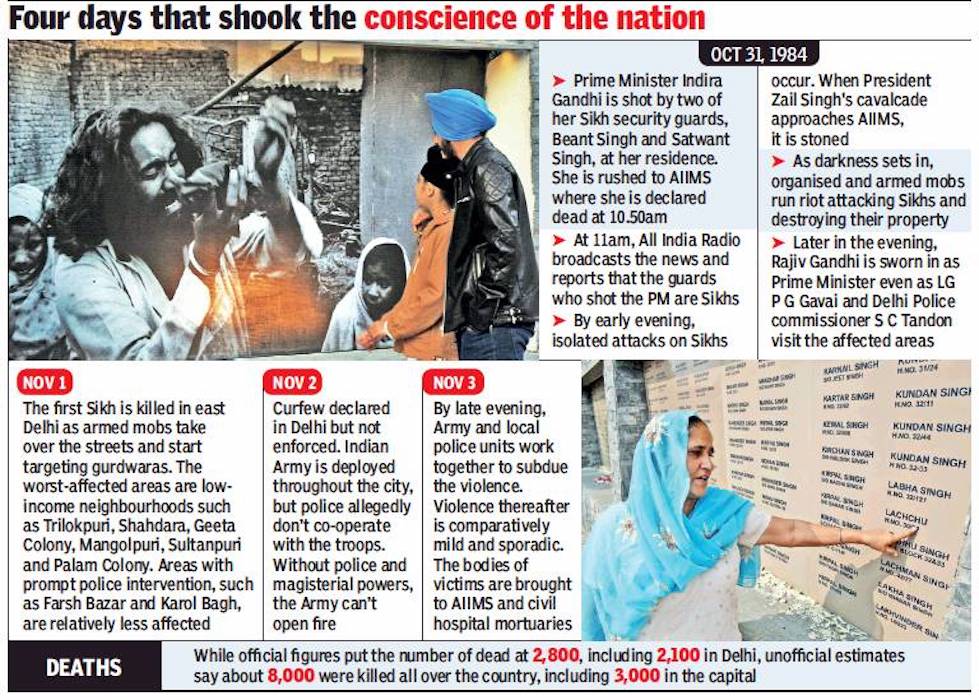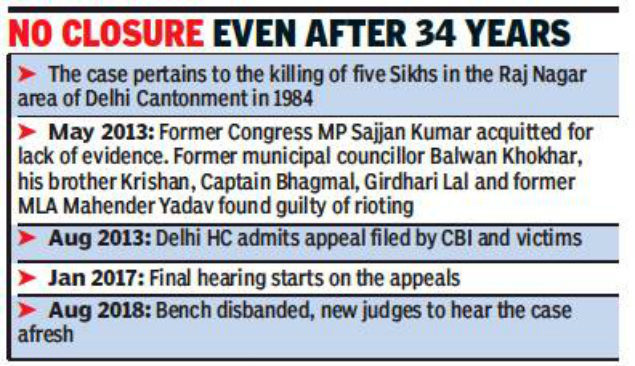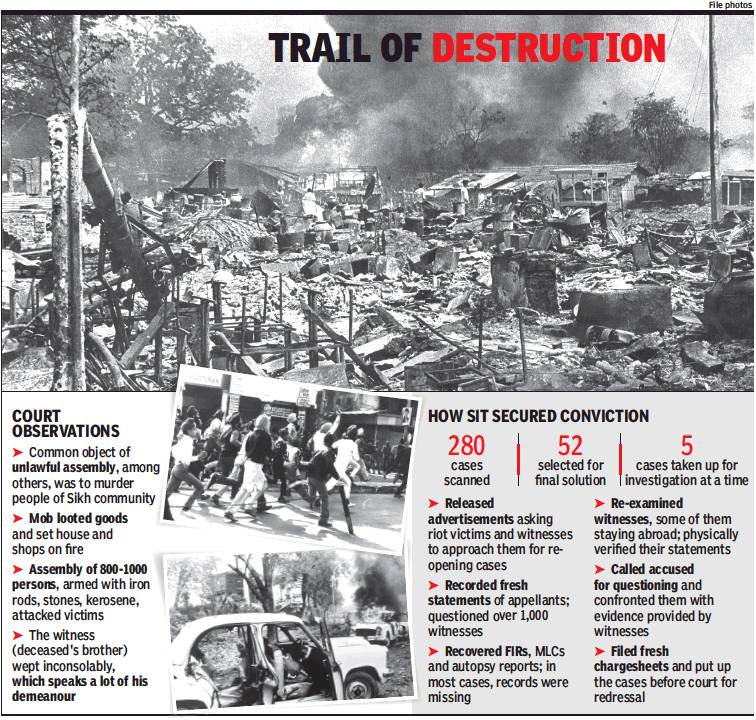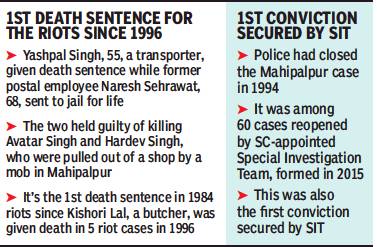1984 riots: India
This is a collection of articles archived for the excellence of their content. |
Contents |
1-4 November: The riots

From: January 11, 2018: The Times of India
See graphic:
The Anti-Sikh riots of 1-4 November, 1984: a timeline
Proceedings in Delhi HC
Status in 2018
Abhinav Garg, 1984 riots: Judge’s transfer wrecks hopes, August 14, 2018: The Times of India

From: Abhinav Garg, 1984 riots: Judge’s transfer wrecks hopes, August 14, 2018: The Times of India
Many victims of the 1984 anti-Sikh riots expecting relief from court felt as if the clock had turned back. They had hoped for a decision on their plea filed in 2013 in the Delhi high court. But with Justice Gita Mittal’s transfer as chief justice of J&K high court, the bench she headed for dedicated hearing on a batch of appeals and revision petitions stood disbanded, leaving people like 80-year-old Jagdish Kaur — who was hoping for some closure after 34 years — distraught.
It means the matter that HC wanted to fast-track will have to be heard “de-novo” (once again) by a new bench, erasing the progress made since January 2017.
After taking charge as acting chief justice, Mittal had retained the riot cases she was earlier hearing and fixed every Thursday and Friday of a week for dedicated sessions. The move came after HC took note of the “delay occasioned in adjudication of these matters, which have their genesis in offences of the year 1984” and added that “certainly, a quietus needs to be brought to the entire litigation at the earliest”. But “quietus” appears far fetched for Jagdish and other widows such as Sampooran Kaur who lost their husbands or sons in the riots 35 years ago in riots that broke out in Delhi Cantt area following the assasination of Prime Minister Indira Gandhi.
Jagdish, CBI’s prime witness in the case lost her husband Kehar Singh; elder son Gurpreet and cousins Narinder Pal Singh, Raghuvinder Singh and Kuldeep Singh in the riots. Apprehensive of further delay in the appeal, she had only last month filed an application urging HC to conduct day-to-day hearing to enable an early judgment. “The appellant has withstood the test of time, in as much as it has been 34 years since the tragic and brutal murder of her family members. It is her life’s objective she may see final adjudication of the matter in her life time,” her plea said.
These appeals had reached HC after a trial court acquitted Congress leader Sajjan Kumar in 2013 but held five others guilty. While the CBI challenged Kumar’s acquittal along with the victim families, the latter also demanded enhancement of punishment to the convicted men. These were cases that were re-opened in 2005 on the recommendations of Justice Nanawati Commission leading to registration of FIRs. Speaking to TOI, Nirprit Kaur rued the “missed opportunity” for victims. Kaur, who used to travel from Chandigarh to attend the Thursday/Friday hearings, sounded crestfallen. “We are back to zero, because the matter which had been kept part heard since 2017, will now be heard once again. For Yakub Memon the court can remain open entire night but for us even twice a week we couldn’t get a proper hearing. Loss is ours,” she said.
Senior advocate H S Phoolka, who has for years spearheaded the fight for justice, admitted that the victims were very agitated and frustrated due to the delay. “They even wanted to go to the Supreme Court to stop Justice Mittal’s transfer till a judgement was delivered, but I persuaded them not to do it, because she is a good judge,” Phoolka told TOI.
Nov 2018: HC upholds conviction of 70 rioters
Abhinav Garg, November 29, 2018: The Times of India
The Delhi high court upheld the conviction of 70 out of 89 people sentenced to five-year imprisonment by a trial court in 1996 for rioting, burning houses and violation of curfew during the 1984 anti-Sikh riots in the capital.
Since the convicts accused have been out on bail after serving a short term behind bars, the court asked them to surrender immediately to serve their remaining prison terms for violence in east Delhi’s Trilokpuri — one of the worst-hit localities during the riots — between October 31 and November 3 in 1984.
Of the remaining 19 people, 16 had died during the pendency of their appeals while three had their plea dismissed after they absconded.
Writing the verdict, Justice R K Gauba lamented how the process of deciding the guilt of the accused was “reduced to the level of (an) academic (exercise)” as it came up before the court “34 years after the crimes were committed and 22 years after the trial court had given its decision”.
Pulling up the trial court, the HC noted that it “lacked clarity” as to why no case for a graver offence such as murder was made out as a large number of persons had died in the violence.
Case merits more severe punishment, says HC
The suspicion that a politico-criminal nexus, aided and assisted by police or civil service officials, was “behind the mayhem that was wreaked, virtually with impunity or immunity, continue to abound and haunt,” the HC said.
The court had strong words to say on the failure of the criminal justice system in the case. “(That) the criminal justice administration may falter or crumble, or lose its potency, is no longer a distant doomsday scenario.... It appears to have arrived and stares at us in the face,” the judge observed, while dismissing the 22-year-old appeals.
HC noted in its verdict that prosecutions in this case covered only 73 homicidal deaths, whereas a total of 95 bodies were “gathered during the night of November 2-3, 1984” as per the FIR. “It is likely that 22 homicidal deaths may not have seen any criminal action initiated against anyone till date” it said, asking Delhi’s police commissioner to have the material and the evidence “re-examined by an appropriate agency for further action under the criminal law”.
It pointed out that “the fact that these cases have continued to linger in the courts at the stage of trial or appeals or revisions till date itself is an indicator of the reality that the response of the law has been tardy, ineffective and highly unsatisfactory”.
The court said in view of the extensive damage was caused by the appellants to a large number of houses or other properties of Sikh community, the case merited more severe punishment than the one meted out by the trial court. But in the absence of any appeal seeking enhancement of punishment and the trial court having taken a lenient view “there is no occasion for this court to modify the order on sentence either way”.
Justice Gauba noted that of all the bodies recovered after the rioting, 22 remained unidentified and it was likely that no prosecution was initiated against anyone in respect of these deaths.
HC also suggested reforms, like amending the Commissions of Inquiry Act, 1952, and the Protection of Human Rights Act, 1993, to entrust such bodies with the responsibility of taking note of cognisable offences committed during communal riots, investigating through SITs under their control and overseeing prosecution through special public prosecutor(s) engaged by them.
The process of deciding guilt of the accused has been reduced to an academic exercise as it came up before the court 34 years after the crimes were committed and 22 years after the trial court had rendered its decision — Justice R K Gauba
The SIT investigation
The odds

From: Somreet Bhattacharya, Missing papers, untraceable witnesses: SIT’s biggest enemy was time in ’84 riots, November 15, 2018: The Times of India
How Task Force Formed In 2015 Joined The Dots
The special investigation team, whose inquiry findings led to the conviction of two men in the anti-Sikh riots of 1984, was formed after the Union home minister ordered it on February 12, 2015. The SIT, comprising an IPS officer, a retired judge and a DANIPS officer, had the almost impossible task of conducting a fresh probe into all cases relating to the riots.
Over the passage of 30 years, some complainants and witnesses had moved out from their original colonies, while others had died. Even the policemen who had originally handled the cases had retired or left Delhi. The riot sites too had undergone changes since.
However, the SIT, assisted by a team of around 50 cops, started a systematic effort to join the dots. Led by IPS officer Anurag Kumar, DANIPS officer Kumar Gyanesh and justice Rakesh Kapoor, the SIT was notified as a police station with jurisdiction over entire Delhi. Immediately after its constitution, it issued advertisements requesting riot victims to once again report their cases. The panel members scanned through 650 cases, sorting out 280 which were unresolved.
In most of the cases, the witnesses or the accused were no longer alive. Documents related to some medico-legal cases and autopsies were discovered to be missing, but if found damaged, were retrieved with the help of conservation experts. In some cases, victims had kept documentary records secure along with photographic evidence.
Enquiring into a case registered at Mehrauli police station, the SIT realised that a politician had been acquitted despite a chargesheet filed against him in 1985. The FIR named Surjeet Singh, Sangat Singh and Kuldeep Singh as witnesses in the case. The cops contacted Sangat Singh, who now lives in Jalandhar, and recorded his statement. He also assisted police in contacting the others.
The SIT discovered that though the politician was named in the FIR, it was his associates Naresh Sehrawat and Yashpal Singh who murdered Sangat’s family members during the riots. The two men led a thousand-strong mob in Mahipalpur village and burnt down the grocery shop of Hardev Singh, Sangat’s brother. Hardev, brother Kuldeep and cousin Avtar Singh took shelter with their neighbour Surjeet Singh. The mob detected them there, and SIT said Sehrawat poured kerosene on Surjeet’s belongings and set his house on fire.
According to the investigation, the rioters used Surjeet’s kirpan to stab him, Hardev, Avtar, Sangat and Kuldeep. Before ransacking the house, they threw the injured men off the first floor terrace. The five were admitted to Safdarjung Hospital, where Hardev and Avtar died. After recovery, some family members shifted to Punjab, others went overseas. The cops contacted a relative, Ratan Singh, who had identified the bodies, and the Italy resident agreed to depose. He recorded his statement in September last year. Both Sehrawat and Yashpal Singh were chargesheeted based on his statement.
The investigative team filed the chargesheet on January 31. During the trial, 18 prosecution witnesses were examined. On October 31 last year, charges for one of the cases registered in Mehrauli were framed after final arguments.
The SIT is now probing three cases registered in Janakpuri, Vikaspuri and Saraswati Vihar, all of which name Congress leader Sajjan Kumar as the accused. Kumar has been questioned five times in the past three years. Some of the witnesses now staying in the US are being examined before chargesheets are framed in the cases. Three others cases are pending investigation. The SIT has also transferred a case that was being probed by CBI.
The testimony of victim’s kin proved crucial in court
Aamir Khan2, November 15, 2018: The Times of India
It was an eyewitness testimony that proved crucial in the conviction of a duo accused of killing two Sikh men during the 1984 riots in the capital.
According to the testimony, relied upon by public prosecutor S K Kain, a Congress leader and one of the accused, Naresh Sehrawat, were leading the mob, exhorting it to attack and kill Sikhs. The testimony was given by Sangat Singh, the brother of one of the victims, Hardev.
He claimed that when the mob moved towards them, he and Hardev ran to take refuge in the room of one Surjeet Singh, who too was a witness in the case. While running, they looked back and saw their shops being looted and burnt.
The Congress leader and Sehrawat are said to have followed the two, smashing the window, to attack the three brothers — Hardev, Sangat and Kuldeep — as well as Surjeet and others. They, in fact, attacked Hardev with his own kripan (dagger) and set the room on fire. Sangat, Kuldeep and Surjeet, besides Dara Singh and Mohan, were injured in the attack. Sangat regained consciousness on November 5 at a hospital and discovered that his brother had been killed.
It was Kuldeep’s demeanour that proved to be critical for the court took note of the “deep impact” the incident had had on his psyche. During his deposition in January this year, he had wept inconsolably and his eyes had turned red. “His testimony remains unshaken and consistent,” judge Pandey observed.
Defence counsel O P Sharma had argued that the investigation agency had not examined any independent person from the village. He pointed out that the investigation had not shown the recovery of any weapon used in the crime. The judge, however, observed that such a recovery, given the lapse of over 30 years, was virtually impossible.
On the point about not examining any independent witness, the court said: “It was difficult for any person with a good conscience to witness the same.” It pointed out that finding other eyewitnesses — except for the victims and their relatives — posed a hurdle as anyone else would have been a part of the mob.
Both accused were also convicted of dacoity, attempt to murder and other serious charges for they attacked the victims with a common intention and burnt their business establishments.
The murder charge attracts a maximum sentence of death penalty. The court will be pronouncing its order on the quantum of punishment on Thursday. The other charges besides that of murder are under IPC Sections 452 (house break for hurt, assault or wrongful restraint); 307 (attempt to murder); 324 (voluntarily causing hurt with dangerous weapons or means); 395 (dacoity); and 436 (mischief by fire) read with 149 (unlawful assembly guilty of common object).
According to the witness, a Cong leader and one of the accused, Naresh Sehrawat, were leading the mob, exhorting it to attack and kill Sikhs
Sessions court, Delhi
2018, Nov: Man sentenced to death for 1984 riots

From: Aamir Khan2, Man gets death for 1984 riots in case reopened after 21 yrs, November 21, 2018: The Times of India
Life Sentence For Another; Both Fined ₹35L
Almost exactly 34 years after anti-Sikh riots shook Delhi, a city court, in a “rarest-of-rare” judgment on Tuesday, sentenced a 55-yearold man to death and sent
another to prison for life after having held them guilty last week of killing two Sikh youths and other heinous crimes during the 1984 violence.
“The case of this kind breaks the entire fabric, trust and harmony amongst communities, thereby severely affecting the assimilation of different religious and social groups,” additional sessions judge Ajay Pandey observed.
In an unprecedented move, the order sentencing Yashpal Singh to death and Naresh Sehrawat to life imprisonment, was pronounced inside Tihar Jail due to security concerns. Earlier, the court had held the duo held guilty of killing Hardev Singh, who was then 24 years old, and Avtar Singh, 26. Three other men, Sangat Singh, Kuldeep Singh and Surjeet Singh, were injured in the mob attack.
“The culpability of both convicts falls within the category of rarest of rare cases,” the judge held, adding that the both men were influential neighbours of the victims. They committed the “horrendous” crime of murder and loot to eliminate the victims without any provocation, merely on the basis of the latter’s faith, community and religion.
This was the first conviction secured by the Supreme Court-appointed special investigation team (SIT), formed in 2015 to reopen Sikh carnage cases. The court also imposed fines of Rs 35 lakh each on the convicts.
The 1984 riots had led the Sikh community being “severely prejudiced” with regard to their life and livelihood, and had led to large scale migration, the judge said.